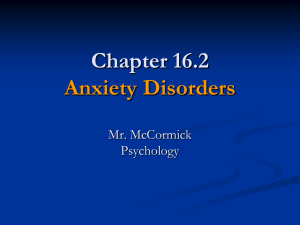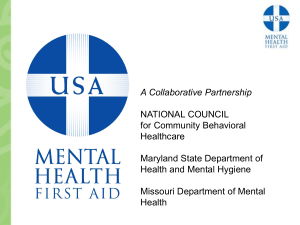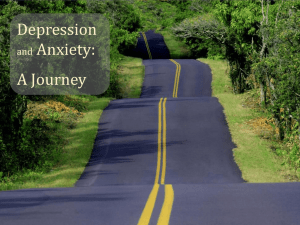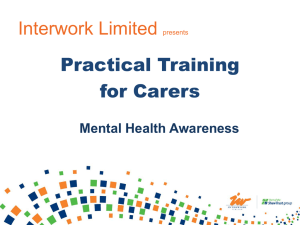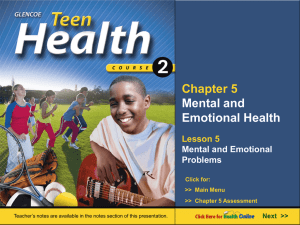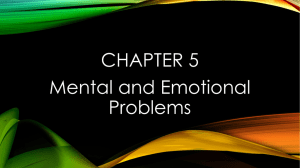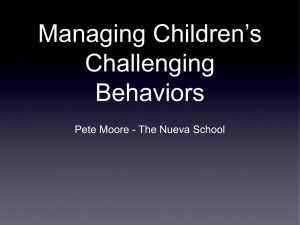- Integration of Psychiatry into Primary Health Care
advertisement
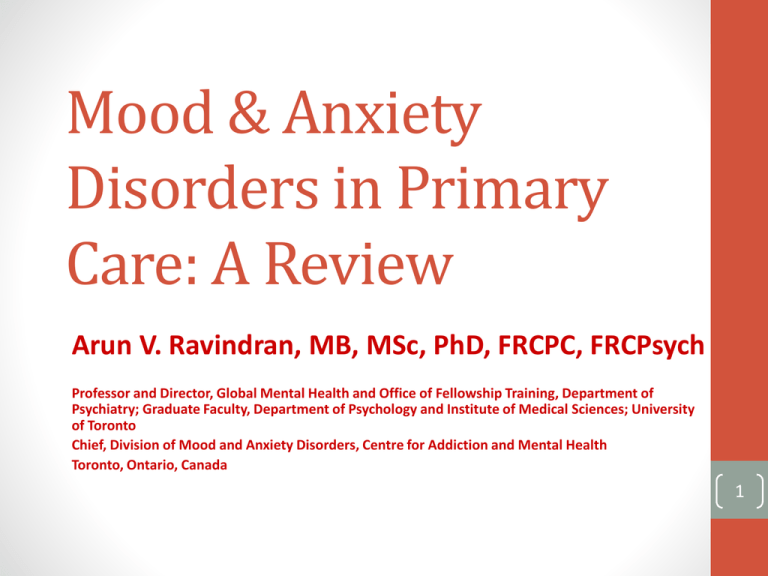
Mood & Anxiety Disorders in Primary Care: A Review Arun V. Ravindran, MB, MSc, PhD, FRCPC, FRCPsych Professor and Director, Global Mental Health and Office of Fellowship Training, Department of Psychiatry; Graduate Faculty, Department of Psychology and Institute of Medical Sciences; University of Toronto Chief, Division of Mood and Anxiety Disorders, Centre for Addiction and Mental Health Toronto, Ontario, Canada 1 Anxiety Disorders 2 Anxiety What is Anxiety? • Diffuse, unpleasant, vague sense of apprehension often accompanied by autonomic symptoms When do you treat Anxiety? • “Anxiety symptoms exist on a continuum and milder forms of recent onset often remit without treatment.” • Need for treatment determined by: • • • • Severity and persistence of symptoms Presence of co-morbidity Disability + Impaired function Impact on social function 3 The Spectrum of Anxiety Disorders Posttraumatic stress disorder Social anxiety disorder Depression Panic disorder Obsessive-compulsive disorder Generalized anxiety disorder 4 Co-morbidity in Anxiety Disorders Anxiety Disorders Somatoform Disorders Medical Conditions Mood Disorders Substance Use Disorders 5 Anxiety Disorders – DSM-IV – Fear vs. Distress Disorders Panic Disorder Agoraphobia Specific Phobia Social Phobia PTSD ASD OCD GAD AD / GMC / SU / NOS 6 Key Fears in Anxiety Disorders • • • • • • PD/A – Dying, going crazy or losing control SP – Harm from an external object or situation SAD – Humiliation or embarrassment GAD – Future events involving real life concerns PTSD – Re-experiencing trauma in memories/dreams OCD – Harm, uncertainty, uncontrollable actions 7 Epidemiology of Anxiety Disorders Disorder Life Time Prevalence Panic Disorder Specific Phobias Agoraphobia Social Phobia General Anxiety Disorder Post Traumatic Stress Disorder Obsessive-Compulsive Disorder As a group 2 – 5% 1 – 19% 0.2 – 5% 5 – 12% 1 – 6% 2 – 8% 2 – 3% 20-30% 8 Psychophysiology of Anxiety Disorders Triple Vulnerability Model Genetic contribution to temperament Generalized Biological Vulnerability Generalized Psychological Vulnerability Disorder Early Learning Experiences and Familial/Social Environment Sense of diminished control 9 Key Decision Points in the Management of Anxiety Disorders A. Identify anxiety symptoms Determine if anxiety causing distress or functional impairment Assess suicidality B. Differential diagnosis •Is anxiety due to other medical or psychiatric condition? •Is anxiety comorbid with other medical or psychiatric condition? •Is anxiety medication-induced or drug-related? •Perform physical exam & baseline laboratory assessment C. Identify specific anxiety disorder Panic, specific, SAD, OCD, GAD, PTSD Co-morbid mental disorders •If substance abuse: avoid BZDs •If another anxiety disorder: consider therapies that are 1st-line for both disorders •If mood disorder: consider therapies that are effective for both disorders, also refer to depression or bipolar disorder guidelines D. Consider psychological and pharmacological treatment •Patient preference and motivation extremely important when choosing treatment modality •If formal psychological treatment not applied, all patients should receive education and support to encourage them to face their fears Comorbid medical conditions If medical: assess benefits and risks of medication for the anxiety disorder, but consider impact of untreated anxiety BZD=benzodiazepine, SSRI=selective serotonin reuptake inhibitors, SNRIs=serotonin norepinephrine reuptake inhibitors MAOIs=monoamine oxidase inhibitors 10 Treatment of Anxiety Disorders in Primary Care: General Principles • Screening • Beck Anxiety Inventory (BAI; 21 items) • Interventions • Pharmacotherapy (mild to moderate) • CBT (mild to moderate) • Antidepressants + CBT (moderate to severe) • Maintain antidepressants + CBT boosters – 1-2 years 11 The “CBT Package” – The Proven Intervention • • • • • • Psychoeducation Monitoring/early cue detection Applied relaxation Imaginal and in vivo exposure Coping skills rehearsal Cognitive restructuring 12 Case History Jenny, 56-year-old accountant, married with three grown children • Describes herself as a ‘worrier’ • Has worried more “for the past 1 year” about her children’s health, finances, marital relationship, the future Jenny is likely suffering from: Clinical Depression Generalized Anxiety Disorder Adjustment Disorder Alcohol dependence What further information is useful in her diagnosis? 13 Generalized Anxiety Disorder (GAD): The Facts “Inappropriate and/or extreme worry with multiple somatic anxiety” - Restlessness - Poor concentration - Fatigue - Irritability - Sleep difficulties - Tension • 5% of the general population • Onset in adolescence, disability and chronic course • Comorbidity and vulnerability to MDD 14 Treatment of GAD • Pharmacotherapy • • • • • Antidepressants Beta blockers Benzodiazepines Anticonvulsants Buspirone • Psychotherapy • CBT • Recent advances • Focus on “worries” • Mindfulness and acceptance 15 Case History Sam, 24-year-old computer programmer, single and living on his own • 1 year history of physical symptoms • Has seen several physicians – multiple investigations • Convinced that he has heart disease and believes that it is being missed Which of the following is most likely? Hypothyroidism Panic Disorder Schizophrenia Incompetent Physicians 16 Panic Disorder and Panic Disorder with Agoraphobia (PD/A) “Characterized by panic attacks and avoidance behaviour” • Prevalence • Lifetime 3-5% • Specialty clinics 10-60% • • • • Impaired function High rates of utilization Early evidence of anxiety Common medical/psychiatric co-morbidity 17 PD/A Diagnosis (DSM-IV) Diagnostic criteria: recurrent panic attacks 4 or more of the following: Dyspnea or the sensation of being smothered Depersonalization or derealization Fear of going crazy or of losing self-control Fear of dying Palpitations or tachycardia Sweating Trembling or shaking Feeling of choking Chest pain or discomfort Nausea or abdominal upset Dizziness, feeling of unsteadiness or faintness Numbness or tingling sensation Flushes or chills Cognitive symptoms Physical symptoms 18 BillyCrystalandRobertDe Niroin AnalyzeThis–PanicDisorder 19 Treatment of PD/A • Pharmacotherapy • Antidepressants • Benzodiazepines • Psychotherapy • CBT plus • Breathing retraining • Relaxation exercises • Recent advances • Mindfulness based CBT (MBCT)/Mindfulness based stress reduction (MBSR) • Sensation focused intensive treatment (SFIT) • Virtual reality exposure therapy 20 PD/A: Treatment Outcomes • CBT vs. pharmacotherapy vs. combination • • • • Similar benefit short-term CBT better on long term CBT useful Sequential PT + CBT – new trend • In General • Low remission rate – 20-50% • High rates of relapse – 25-85% on discontinuation Good initial response – less probability of relapse 21 Case History Brian, 30-year-old graduate student, engaged to be married in 6 months • Is very anxious and apprehensive about the event • “I don’t like being looked at”, “I think people will laugh at how I look or what I say” • History of shyness, being ‘quiet’ What further information would be useful for diagnosis? What is the likely diagnoses? 22 Social Phobia/Social Anxiety Disorder (SAD) 23 Barbra Streisand Donny Osmond Carly Simon SAD: Signs and Symptoms Cognitive: • Fear of scrutiny, humiliation and embarrassment, • Exposure promotes anxiety Physical: • Blushing, sweating, tremor Behavioural: • Avoidance and anticipatory anxiety in social/performance situations • Good Insight 24 NicholasCageinAdaptation–SocialPhobia 25 Treatment of SAD Pharmacotherapy vs. CBT vs. combination Goals: • Improve cognitive and physical symptoms • Reduce anticipatory anxiety and avoidance • Treat comorbid conditions • Improve functioning Methods • Psychoeducation • CBT plus • Social skills training • Exposure therapy 26 27 Performance-Specific Anxiety • SAD vs. shyness vs. performance anxiety • Proposed overlap with non-generalized SAD • Evidence for benefit with propranolol (RCTs) • Surgical patients and surgeons • Dental patients • Medical students • Benzodiazepines – decrease anticipatory anxiety but may impair performance 28 Specific Phobias Specific phobia is excessive or irrational fear of object or situation, and is usually associated with avoidance of feared object • Lifetime prevalence: 12.5% • Median age of onset: 7 years Common Phobias: animal and blood-injection, claustrophobia, heights Treatment • Pharmacotherapy: Difficult to use and unproven • Psychotherapy: In vivo and virtual exposure 29 Case History Sonya – 33 year old housewife brought against her wishes by her husband • Vague complaints – 3-4 years • “I don’t understand what is wrong with her” – husband • Superstitious about leaving the house without knocking on the door posts. “It’s bad luck if I don’t.” • Spends half an hour each night checking and double-checking that the doors and windows are locked and all kitchen appliances are turned off • Not able to cope with housework because she spends too much time on one task. “I’m a perfectionist.” What would your diagnosis be? 30 Obsessive Compulsive Disorder (OCD) • Obsessions and/or compulsions • Recurrent, persistent ideas, thoughts, impulses or images • Repetitive, purposeful and intentional behaviours that are performed in response to an obsession • Repetitive, unpleasant and ego dystonic + resisted • Excessive/unreasonable • Marked distress and impact on functioning • Affects 2-3 % of the population, with onset in teens 31 OCD: Common Obsessions and Compulsions • Obsessions • Repetitive thoughts about contamination • Repetitive doubts • Intense need for orderliness and symmetry • Aggressive impulses • Repeated sexual imagery • Compulsions • Behaviours • • • • • Hand washing Ordering Checking Demanding reassurance Repeating actions • Mental Acts • Counting • Repeating words silently 32 JackNicholsoninAsGoodAsItGets-OCD 33 Treatment of OCD • Pharmacotherapy • Serotonergic agents • AAPs • Combination • Psychotherapy • CBT with focus on • • Exposure and response prevention Cognitive interventions • Poorer outcomes in • Males • Early onset • Delayed treatment 34 Case History Goran, a 47-year-old parking attendant • Complains of feeling tired and ‘down’ for the past 5-6 months, since being robbed and beaten up at work last year • Has difficulty sleeping due to nightmares, is ‘jumpy’ and irritable • Feels distant from family and friends • Constant sense of inner and physical tension Do you think Goran is suffering from: Fibromyalgia Fatigue Post traumatic stress Overwork 35 PTSD: Key Features • Exposure to threat to life or physical integrity AND • Emotional reaction of fear, helplessness or horror Persistent intrusive reexperience of the event Avoidance of trauma-associated stimuli and + numbing – emotional and behavioural withdrawal Persistent symptoms of increased arousal Duration 1 month to years Prevalence 3-4 % High risk of suicide 36 DamianLewisinBandofBrothers-PTSD 37 PTSD - Treatment Both Pharmacotherapy and Psychotherapy are useful Pharmacotherapy • Antidepressants and atypical antipsychotics Psychotherapy • Trauma focused therapies best results • CBT, exposure therapy beneficial • Less effective - IPT, psychodynamic therapy, supportive therapy • Different types of trauma may respond to different psychotherapies, benefit across subtypes 38 Acute Stress Disorder Follows within 1 month acute exposure to threat and lasts few days to 4 weeks Intervention: Brief and immediate Focus on high risk population Components: • Information Education • Psychological support • Crisis intervention • “Emotional first aid” Does immediate intervention prevent PTSD? 39 Anxiety Disorders: Primary Care Perspectives • Often present with somatic symptoms or complaints related to co-morbid conditions • High utilizers of primary care • May need to treat multiple anxiety disorders • Education and CBT-based brief interventions useful • Deal with barriers to care 40 Unipolar Depression 41 A Case History Maria, a 47-year-old married lady, reports feeling ‘not her usual self’ for the past 6-8 months • She reports feeling both sad and anxious • She has difficulty sleeping and is always tired • Her appetite has decreased and she has lost 15 lbs. in the past 6 months • Her brother died in a car accident about 1 year ago. She feels guilty about an argument they had just before, and thinks about it a lot. What is your diagnosis? 42 Mood/Affective Disorders Definition: Mental illnesses presenting with altered mood/affect as the primary symptom • Affect: External expression of an internal state (i.e. mood) • Affect is more transient, mood is more sustained • Two broad syndromes of mood disorders • Depression • Mania 43 How Common Are Mood Disorders and What is Their Disease Burden? • Life time prevalence • Unipolar depression 8-20% • Bipolar disorder 1% • WHO: Depression is the leading cause of disability • Impact on: • • • • Quality of life Impaired function (occupational, social) Suicide Physical health 44 What Causes Mood Disorders? • Genetic vulnerability • Social and environmental factors • Life stressors • Early childhood experiences • Social determinants • Neurobiological factors • Neurotransmitter/neurohormonal challenges • Neural circuitry Usually a multi-factorial etiology 45 Defining a Depressive Disorder (DSM) • Clinically significant behavioural or psychological syndrome, associated with • Distress/disability • Increased risk of death/pain • Not simply • Lowered mood • Response to loss • Maladaptive reaction to stress • Two key forms • Major depressive disorder (MDD) • Dysthymic disorder (DD)/Persistent depressive disorder (DSM5) 46 Depression is Complex, Multidimensional Emotional Symptoms • • • • Feelings of guilt Suicidal Lack of interest Sadness Associated Symptoms Physical Symptoms • Lack of energy • Decreased concentration • Change in appetite • Change in sleep • Change in psychomotor skills APA. DSM-IV-TR; 2000:352,356. • • • • Brooding Obsessive rumination Irritability Excessive worry over physical health • Pain • Tearfulness • Anxiety or phobias 47 NicoleKidmaninTheHours-Depression 48 What Are the Important Subtypes of MDD and DD? • • • • • • Chronic depression Melancholic depression Atypical depression Psychotic depression Postpartum depression Seasonal affective disorder 49 How Do Patients with Depression Present in Primary Care? • • • • Less than 20% seek help from family physicians Only 50% are recognized as depressed 2/3 present in practice with somatic symptoms only Common screening tools for primary care • Brief Hamilton Depression Rating Scale (HDRS; 7 items) • Beck Depression Inventory (BDI-II; 21 items) • Patient Health Questionnaire (depression only) (PHQ-9; 9 items) • Screening tools are specially useful in high risk populations 50 High Risk Groups and Symptomatic Presentation of MDD High Risk Clinical Groups High Risk Symptom Presentations Past history of depression Unexplained physical symptoms Family history of depression Pain Psychosocial adversity Fatigue High users of the medical system Insomnia Chronic medical conditions Anxiety Other psychiatric conditions Substance abuse Times of hormonal challenge 51 Patten et al., 2009; J Affect Disord. Managing Depression in Primary Care • Assessment • • • • Suicide risk Physical health Psychosocial issues Psychiatric morbidity • Management: “Stepped care approach” • • • • Watchful waiting Guided self-management Brief psychological/pharmacological interventions Referral to specialists • Determine diagnosis and point in continuum of care 52 What Are the Phases of Treatment for Depression and Their Goals? • Acute • Target goals • Remission • Restoration of function • Outcome measures • Maintenance • Resolve residual symptoms • Treat co-morbidities • Prevent recurrence Use chronic disease management model 53 What Are the Effective Interventions for Depression? • Pharmacotherapy • Antidepressant agents • Older agents – TCAs, MAOIs • Newer agents – SSRIs, SNRIs, atypical antipsychotics, novel agents • Psychological therapies • Cognitive Behaviour Therapy (CBT) • Interpersonal Therapy (IPT) • Other modalities, supportive therapy • Combination: Medication + psychotherapy • Psychosocial interventions • Neurostimulation • Electroconvulsive Therapy (ECT) • Rapid transcranial magnetic therapy (rTMS) • Investigational modalities • Chronic disease management model 54 Psychotherapy: Best Modalities • Cognitive behaviour therapy (CBT) • Basis: Thoughts, emotions and behaviours are inter-related • Focus on dispelling cognitive misperceptions of self, others and surroundings and modifying maladaptive emotional and behavioural responses • Interpersonal therapy (IPT) • Basis: Problematic interpersonal relationships may contribute to depressive onset and maintenance • Focus on at least 1 key area: Role transitions, Interpersonal role disputes, Grief, Interpersonal deficits • Pick the most appropriate form based on the need • Both forms effective in acute and maintenance treatment 55 Psychotherapy: Other Modalities Psychodynamic psychotherapy Behavioural activation Basis: Psychological dysfunction results from conscious or unconscious conflicts and defense mechanisms Basis: “Depression is a consequence of compromised environmental sources of positive reinforcement” Focus on recognizing the conflict and understanding sources/influences to promote psychological healing Focus on increasing patient activity and rewarding experiences, and de-emphasizing particular cognitions/ mood states Motivational interviewing Computer/internet/telephone psychotherapy Basis: Individuals with dysfunctional behaviours wish to change but lack initiative/commitment CBT, IPT, supportive therapy, etc. in distance delivery formats Focus on resolving ambivalence, building motivation, and working towards specific, realistic goals to achieve the desired change Advantages: Immediate help, anonymity, low cost, flexible schedule, ease of access for remote communities 56 Neurostimulation Therapies ECT rTMS Induction of a convulsion (seizure) by the application of electrical current to the brain Application of a magnetic field (1.52.5T), delivered through the skull Indications: Treatment resistance, intolerant of antidepressants, psychotic depression Indication: Treatment resistance, severe depression Physical and cognitive side effects Short term side effects: Headache and scalp pain. Investigational therapies VNS, DBS and MST 57 How does Depression Affect Physical Health? • Increase the effect of risk factors • • • • • • • • Obesity Smoking Cardiovascular Immune Increase the risk of chronicity Worsen pain disorders Reduce treatment adherence Reduce participation in prevention 58 What is the Long-term Outcome of Depressive Disorders? • MDD • • • • • Variable duration Spontaneous recovery in many Longer illness poor outcome Often recurrent 20% non-recovery and chronic course • Dysthymia/Persistent depressive disorder • Chronic fluctuating course • Superimposed MDD double depression • Poor function 59 Bipolar Disorder 60 Case History Susan, a 20-year-old university student, presents with symptom of 2 months’ duration (worsening in last 2 weeks) • Has started many projects, but is easily distracted and does not complete them – has affected her grades • Is sleeping less (but does not feel tired) • Has been buying unneeded things impulsively from the internet • Her friends say her mood is unpredictable, and that she gets overly excited or angry about even little things. What is your assessment of this patient? 61 Symptom Overlap: The Complexity of Mood Disorders Psychosis Bipolar Mania Mixed State Bipolar Depression Agitated Depression Treatment Resistant Depression Unipolar Depression 62 *All have potential for psychotic presentation/escalation Bipolar Disorder and Bipolar Spectrum Disorders • BP I: Mania with/without depression • BP II: Depression with hypomania - Recurrent MDE with clearcut hypomanic episodes (lasting at least 4 days) • BP Spectrum/ Complex Subtypes • Mixed states: Mania and depression • Rapid cycling, Ultra-rapid cycling, Ultradian • Cyclothymia • Substance/Antidepressant-induced hypomania • Prevalence: • Bipolar I Disorder: 1.2-1.6% • Bipolar II Disorder: 2-6% • Bipolar Spectrum Disorders: 6.4% 63 Bipolar Disorder: Burden of Disease • High degree of psychiatric/physical co-morbidity and psychosocial consequences: • • • • Suicidality Substance abuse Medical illnesses Employment and family problems • Increased mortality than those without bipolar disorder: • 2.5 times more likely to die in 12 months, if untreated • One of the world’s 10 most disabling conditions • DALYs highest in 14-44 year olds 64 Diagnosing Mania Mood: Abnormally and persistently elevated, expansive or irritable Duration: At least one week or requiring admission PLUS Three (four if irritable mood) or more of the following: • Grandiosity • More talkative • Flight of ideas • Distractibility • Less need for sleep • More goal-directed activity • Excessive involvement in pleasurable activities 65 Hypomania: Presentation A distinct period of persistently elevated, expansive or irritable mood, lasting at least 4 days PLUS Three (four if irritable mood) or more of the following: • • • • • • • Grandiosity More talkative Flight of ideas Distractibility Less need for sleep More goal-directed activity Excessive involvement in pleasurable activities More commonly seen in primary care than mania 66 BradleyCooperinSilverLiningsPlaybook-Hypomania 67 What are the common presentations of Bipolar I and II Disorder to the Family Physician? Psychological Physical Depression Alcohol/substance use Anxiety Sexually transmitted diseases Sleep difficulties Fatigue Poor concentration Social Other Marital/relationship problems Episodic impulsivity/risk taking Financial Suicide attempts Occupational 68 The Complex Bipolar Patient • Mixed episodes • Both manic and depressive symptoms • comorbid substance use disorders • risk of suicide and psychosis • Rapid cycling • 4 or more cycles/year with > 8 weeks of well periods • Occurs in Bipolar I and II 69 The Complex Bipolar Patient: Co-morbidities/Complications • Personality disorders (cluster B) • High co-morbidity (up to 92%) • Risk factor for bipolar disorder • Medical conditions • Anxiety disorders • May elevate risk of suicide • Substance abuse • High rates of co-morbidity vs. the general population • Higher prevalence of complex subtypes • ADHD • Bi-directional relationship • Overlap of symptoms • ADHD as a prodrome • • • • Obesity Cardiovascular Endocrine Cerebral pathology • Suicide • 15% suicide rate • 25-50% attempt suicide in lifetime 70 Bipolar Disorders: Management Chronic disease management model: Long term, interdisciplinary, education focused and integrated • Bipolar I Disorder • • • • • Emergency management Acute care/short-term Mixed/rapid cycling states Bipolar mania Bipolar depression • Bipolar II Disorder • Mainly depression • Maintenance treatment and prophylaxis 71 Issues Specific to Primary Care • Diagnostic difficulties – screening tools • Patient Health Questionnaire (depression only) (PHQ-9; 9 items) • Mood Disorder Questionnaire (mania only; 17 items) • • • • • • • Check for “destabilization”/non response to antidepressants Use antidepressants with caution Referral for consultation/shared care Treatment adherence Risk of suicide /financial difficulties Medical issues, e.g. obesity, cardiovascular disease Psychoeducation and support through life transition for patient and family 72 • Relapse prevention What Interventions are Useful for Bipolar Disorders? • Pharmacotherapy • Antipsychotics • Mood stabilizers • Lithium carbonate • Anticonvulsants • Psychotherapy • • • • Psychoeducation CBT, IPT Family interventions Benefits: Improve adherence and function, early identification of relapse and suicidal ideation, prevent suicide • Neurostimulation • ECT 73 Bipolar Patients: Baseline Investigations and Monitoring • • • • • CBC electrolytes Fasting lipids and glucose Liver function levels TSH + ECG Urine analysis Regular monitoring: • The above + • Weight, smoking status and alcohol use • Medication serum levels • Cognitive function 74 75 On a Lighter Note… 76 END 77
